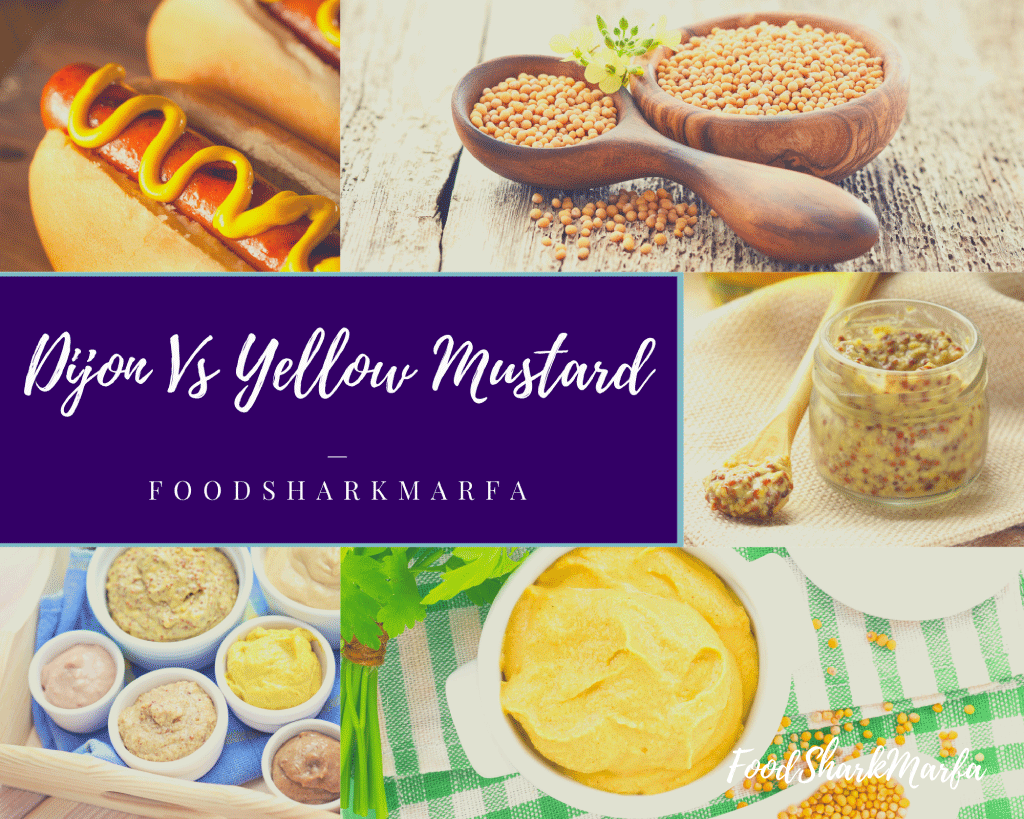Probably one of the most popular of the condiments, mustard is a favorite topping or dip for many snacks, not least hot dogs and pretzels.
Although mustard or yellow mustard is the most popular type in the US, Dijon mustard is also available in grocery stores. If you always ignore the Dijon mustard to pick up your regular squeezy bottle of mustard, then read on to find out why I think you should give Dijon a try next time you wander down the condiment aisle.
In the Dijon vs yellow mustard debate, although they are both mustards and deliver a kick, they are still different. Dijon mustard is made with brown mustard seeds and has a strong and sharp flavor while mustard has turmeric added to make it brighter yellow and as it is made from yellow mustard seeds, it is the milder of the two.
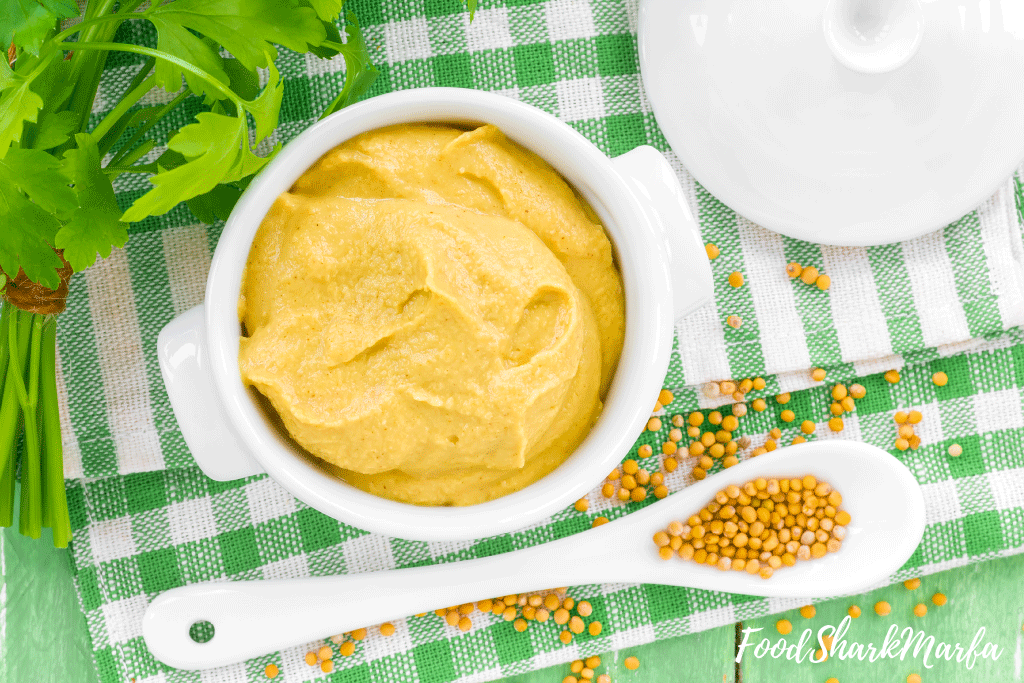
All About Mustard
Mustard has been around for a long time, in fact cooks in Roman times were mixing ground mustard seeds with must, an unfermented grape juice to make mustum ardens, a hot paste. Meaning ‘burning must’ the Latin name was eventually shortened to mustard when it arrived in the English-speaking world.
Mustards are made with different colored seeds that can be ground, cracked, bruised or left whole in the mustard. The yellow mustard seeds (also known as white) used in mustard are the mildest type of mustard seed and these originated in the Mediterranean.
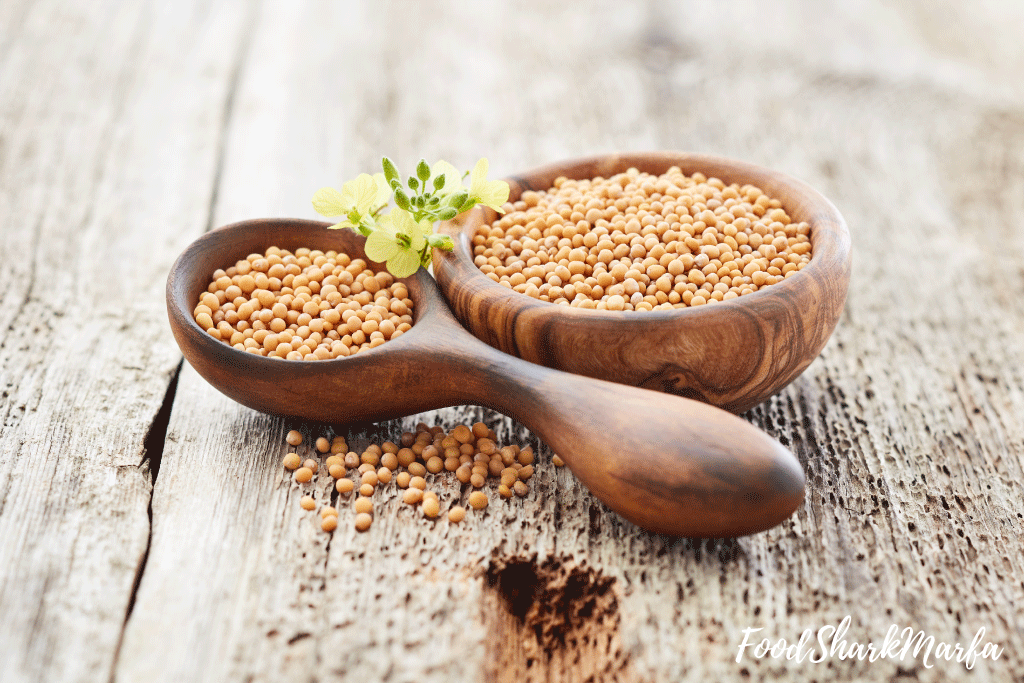
Dijon mustard is made with hot brown mustard seeds that grow in the Himalayas while the other hot seeds, the black mustard seeds, originated in Asia Minor and the Middle East.
Mustard plants belong to the Brassica genus and Brassicaceae or mustard family of plants. Other Brassica plants include cabbage, collard greens, turnip, rutabaga, broccoli and even plants used to make canola oil. There are around 40 different species of mustard plant.
Historically, mustard was also an important medicinal plant, used in poultices and the treatment of various conditions, including toothache. The Ancient Greek philosopher Pythagoras even used it as a cure for scorpion stings!
Exactly Why is Mustard Hot?
The heat in mustard arises when the mustard seeds are ground down and mixed with a liquid. When the seeds are mixed with the liquid, an enzyme in the seeds called myrosinase turns other compounds called glucosinolates in the seeds into isothiocyanate compounds – commonly called mustard oil.
Mustard oil is what gives garlic, wasabi and horseradish their heat and some of the mild flavor and intensity found in cabbage, watercress and broccoli.
Different colored seeds (yellow, brown or black) have different concentrations of glucosinolates which gives the different heat profiles and flavors to mustards.
As well as the type of seed is used and how they are processed affects the kick and flavor of the mustard, how acidic the liquid is added to the seeds also affects the heat and flavor.
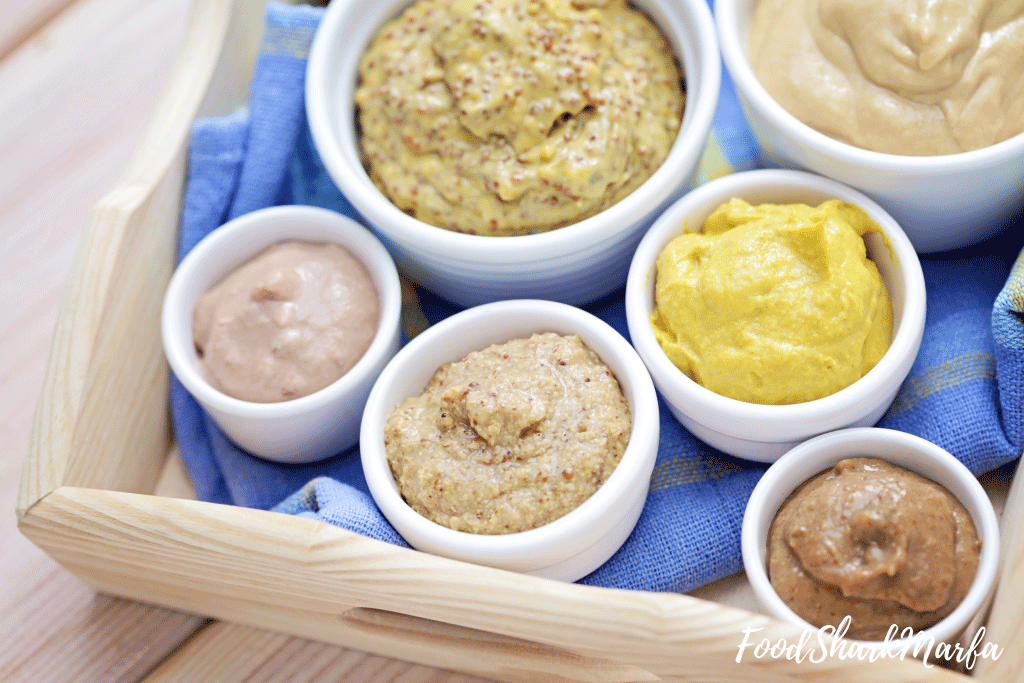
Adjusting any of these factors is how mustard manufacturers can stabilize how much of a kick you will get from a particular mustard.
For example, when an acidic liquid is added to mustard seeds, the generation of the mustard oil is slower than when a more neutral liquid such as water is added.
At the basic level, this means that a mustard made with water will be very pungent at first, but lose its pungency quickly, while mustard made with acid (such as vinegar or lemon juice) has a slower and longer lasting burn.
The temperature of the liquid also affects how active the myrosinase enzymes are in converting the glucosinolates into mustard oil and the bottling, storage and refrigeration of mustard also takes its toll on the heat profile.
This is why when you buy mustard, you should look for ones well in date as this means you will have a hotter mustard.
So, in summary, a mild mustard is one made with yellow seeds and vinegar while a hot mustard is made with brown or black seeds and cold water.
Just What is Yellow Mustard?
Mustard is made from finely ground yellow mustard seeds along with turmeric for color and vinegar and water. It may also contain other spices. Also known as yellow mustard or American mustard, it is a mild and runnier mustard with a sharp and clean mustard flavor.
As well as being popular on burgers, hotdogs, pretzels, mac salad, sandwiches and more, mustard is commonly mixed into marinades, BBQ sauces and dressings.
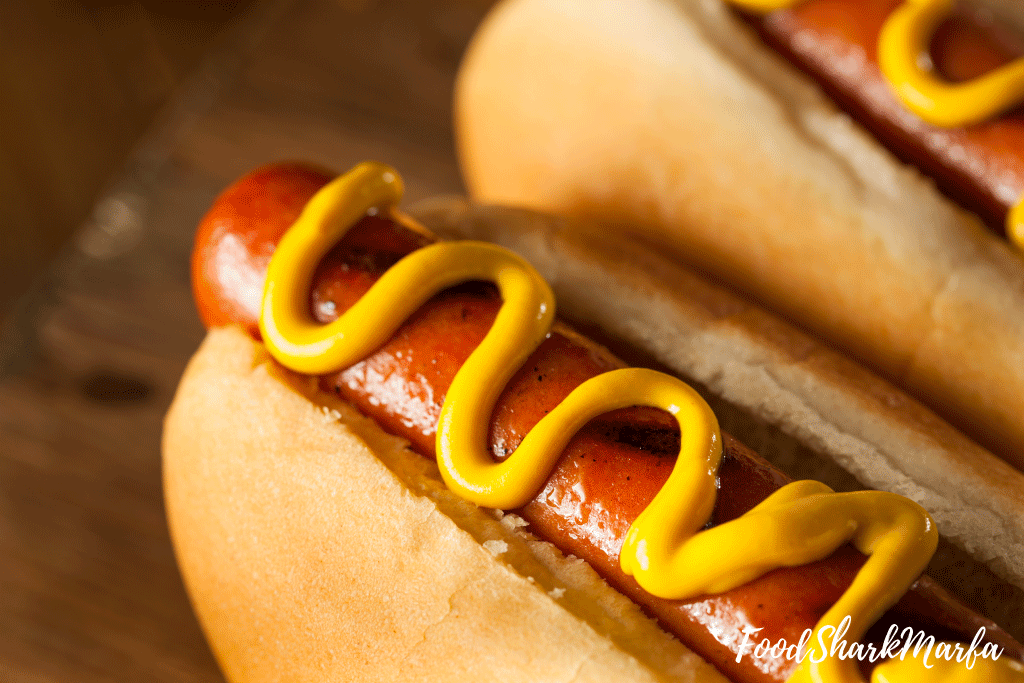
It was thought that mustard was created for the St. Louis World’s Fair in 1904 as a ‘cream salad mustard’ by George J. French and today is the most common type of mustard consumed in the US.
Exactly What is Dijon Mustard?
Dijon mustard is thick, smooth, pale beige/yellow colored mustard with a strong and sharp flavor.
Dijon mustard can be made anywhere but is often based on the recipe devised by Jean Naigeon, a mustard maker in Dijon, a town in Burgundy, France.
At that time, Dijon was the designated district of France for mustard production, something that had been in production since the Romans had taken mustard seeds to Gaul and planted them in vineyards along with the grapes. Although it was being made in French monasteries as far back as the ninth century, mustard did not actually become that popular in France until the 1800s.
In 1856, Naigeon replaced the traditional vinegar used in Dijon mustard with grape juice and in 1866, this new style of Dijon mustard was manufactured by Maurice Grey and Auguste Poupon, under the Grey-Poupon brand still available today.
Other manufacturers embraced Naigeon’s recipe and Dijon mustard was made with the verjuice from unripe grapes instead of the more common vinegar. However, it is worth knowing that many of today’s Dijon mustards have gone back to being made with vinegar, although some are still made with wine or verjuice.
Dijon mustard is made with brown mustard seeds and the combination of these seeds and the acid gives a mustard that is more pungent and robust with intensified heat.
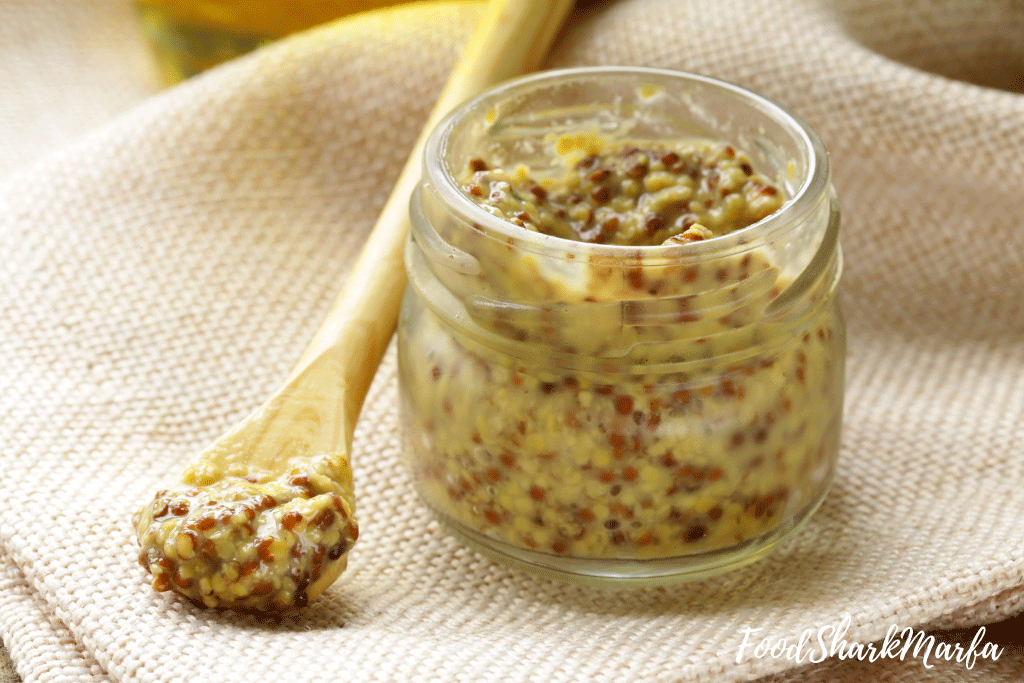
Dijon mustard is just as versatile as mustard for adding flavor to many foods and in fact recipes often ask for Dijon mustard because it has such a sharp and complex flavor, but with the smoothness of a mustard.
It is also a lower fat option than other condiments such as mayo and as Dijon mustard is acidic, it can take the place of vinegar in some salad dressings. It can also emulsify some dressings and stop them from separating.
You can add a teaspoon of Dijon mustard to a glaze or make an easy marinade with honey and lemon. Just like mustard, Dijon mustard is also ideal for adding to favorite dishes such as mac and cheese or eggs.
Can I Substitute Dijon Mustard for Mustard?
Yes of course, you can substitute Dijon mustard for mustard or vice versa, but there are a couple of things to consider first.
If you use mustard instead of Dijon mustard in a recipe, consider if the change in acidity will affect the recipe. A straight switch of Dijon mustard to mustard can cause the recipe to be too acidic as Dijon mustard does not contain as much acid as mustard.
As mustard contains less salt than Dijon mustard, you may need to add a little more salt to the dish. Using mustard instead of Dijon mustard can also give a yellow hue, which depending on the recipe may not be appropriate. If you do not think that mustard would be the best substitute for Dijon mustard for your recipe, there are other Dijon mustard substitutes that may be more suitable.
If you want to use Dijon mustard in place of mustard, you may need to add a little more acidity (such as lemon juice or vinegar) to the recipe and if you need some of the yellow color, then just add a little turmeric to the Dijon mustard.What is The Best Way to Store Mustard?
Unopened, any type of mustard should be stored in a cool, dark and dry place. Because mustards usually contain some form of acid, they can be stored in the pantry once opened, but it is best to use them within a couple of months.
Storing mustards in the refrigerator is usually best as not only can keep it around for up to six months, but it also helps slow down some of the loss in bite that occurs as mustard ages.
Yellow Vs Dijon Mustard – The Nutrition Stakes
In terms of nutrition, both types are low in fat, cholesterol and calories, but Dijon mustard contains more sodium - around 150 milligrams per suggested serving.
Mustard seeds do contain nutrients such as selenium, potassium, thiamine and manganese, but because a serving of mustard is so small (around a teaspoon or so), it adds very little nutritional value to the diet.
Yellow Vs Dijon Mustard – The Bottom Line
Just to recap, the difference between yellow and Dijon mustard is that mustard is made from yellow mustard seeds and turmeric and has a milder flavor while Dijon mustard is made with brown mustard seeds and is stronger and sharper.
They can be used in place of each other in pretty much anything, just consider any differences in acidity and color when using one in place of the other.
I hope that if you have yet to try Dijon mustard, I have now persuaded you to pick one up the next time you are in the condiment aisle, instead of just heading straight for your regular mustard!

